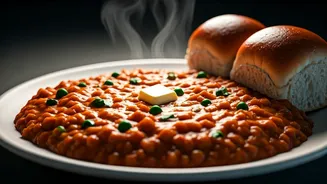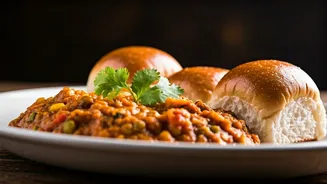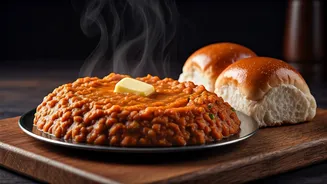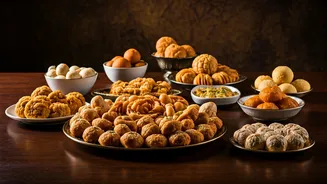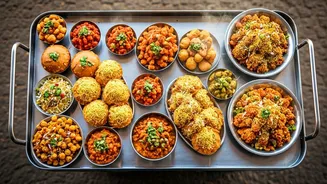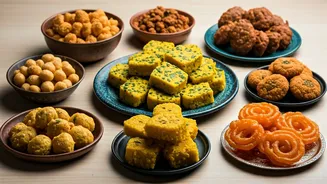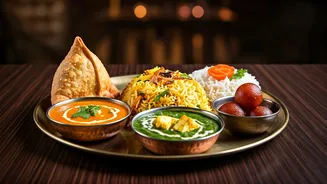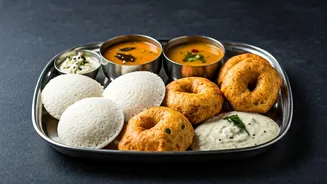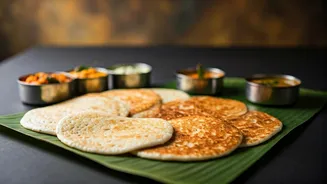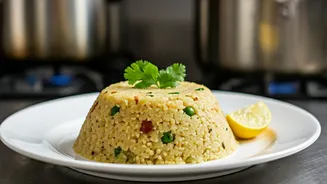Bhaji Basics Unveiled
The heart of Pav Bhaji lies in its bhaji, a medley of mashed vegetables simmered in a rich, spiced tomato base. The traditional recipe usually includes
potatoes, cauliflower, peas, capsicum (bell peppers), and onions. These vegetables are first boiled or steamed until tender, then mashed to a smooth consistency. A flavorful tadka (tempering) is prepared by sautéing onions, tomatoes, and ginger-garlic paste in butter or oil, along with a blend of spices like pav bhaji masala, turmeric, and red chili powder. The mashed vegetables are then added to this flavorful base, simmered until the flavors meld, and garnished with fresh coriander leaves. The bhaji should be thick and have a vibrant color and aroma, which comes from the selection of fresh vegetables and aromatic spices.
Pav: The Perfect Partner
The 'Pav' (bread rolls) is an integral element of Pav Bhaji and the other half of this culinary duo. These soft, fluffy rolls are typically lightly toasted with butter before serving. While the quality of the pav plays a significant role in the overall taste, getting perfectly soft pav is essential. In Mumbai, the pav is often sold by local bakeries who specializes in making the best quality pav. A generous amount of butter is added to a hot griddle, and the pav is toasted until golden brown and slightly crisp. The toasted pav provides the perfect textural contrast to the soft and flavorful bhaji. They should be served warm, with the aroma of butter. The slight crispness on the outside and softness inside of the pav, which provides a comforting experience, enhancing the overall enjoyment of the dish.
Spice Symphony: The Masala
Pav Bhaji masala is the secret ingredient that binds all the flavors together. This unique blend of spices is what gives Pav Bhaji its distinct aroma and taste. Although recipes vary, it usually contains a mix of coriander seeds, cumin seeds, dried red chilies, black peppercorns, cardamom, cinnamon, and sometimes even dry mango powder (amchur). The masala is often roasted and then ground to create a fine powder. The quality of the pav bhaji masala is very important. You can either use a store-bought version or make your own by blending the ingredients. The masala is added during the bhaji preparation, infusing the vegetables with its complex flavors and ensuring a well-balanced taste. The balance of heat, tanginess, and aroma makes Pav Bhaji truly irresistible and a sensory delight.
Assembling Your Masterpiece
Once the bhaji is ready and the pav is toasted, it's time to assemble your Pav Bhaji. The bhaji is served hot, typically with a generous dollop of butter on top. Some also add a squeeze of fresh lime juice for an extra layer of flavor. Chopped onions, coriander leaves, and a lemon wedge are usually served on the side, allowing diners to customize their experience. Place a portion of the hot bhaji onto a plate or bowl, and serve the warm, buttered pav alongside. Take a piece of the pav, dip it into the bhaji, and savor the explosion of flavors and textures. The combination of the spicy, savory bhaji with the soft, buttery pav is what makes this dish such a beloved favorite.
Tips for Success
To elevate your Pav Bhaji experience, consider a few tips. Freshness is key: use the freshest vegetables and spices possible. Adjust the spice levels to your preference by varying the amount of chili powder or pav bhaji masala. Don't skimp on the butter: it’s an essential part of the flavour profile! You can even add a knob of butter to the bhaji while it's simmering to enhance its richness. A cast-iron skillet can enhance the cooking of the bhaji. For an extra layer of flavor, consider adding a pinch of kasuri methi (dried fenugreek leaves) to the bhaji. Experiment with different vegetable combinations to find your favorite version. The best Pav Bhaji is the one you enjoy the most, so feel free to adapt the recipe to your liking and enjoy the process.
